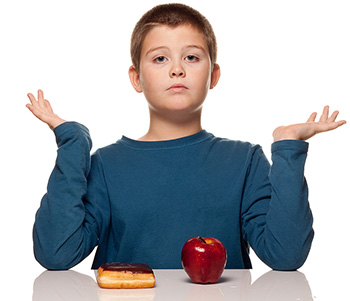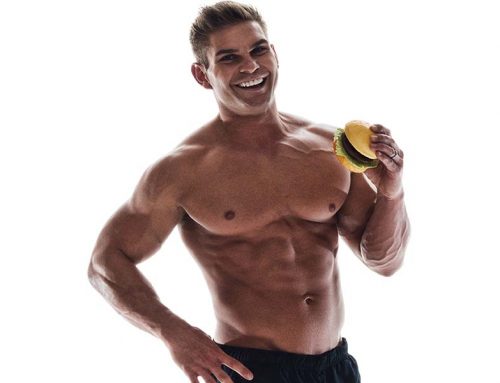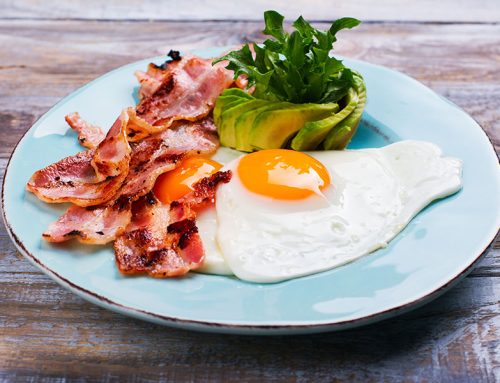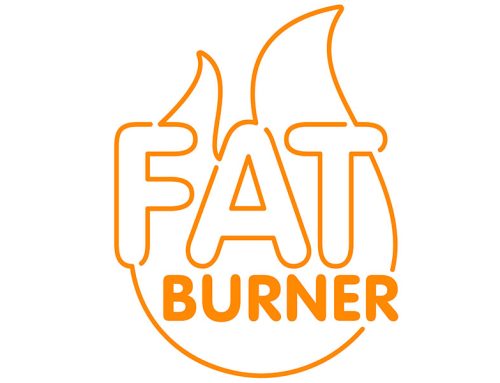If you’ve ever been confused about what to eat to lose weight and get healthy, you’re not alone. No subject has been over-complicated more than “what should I eat?” Fortunately, there’s no subject more easily simplified…

Why does knowing what to eat appear so complicated? Some of the forces at work include weight loss industry marketing, diet tribalism, individual needs that vary, one person’s preferences being generalized to everyone, and very simply, a pervasive belief that nutrition is supposed to be complicated.
Rather than teach simple fundamentals and principles that never change (because they’re too boring and un-marketable), the diet industry is driven by perpetually promoting the next big thing. They spin a story around around it, and all too often, make it complicated so it appears sophisticated.
Half of the popular diets are based on “magic foods” you’re supposed to eat. Usually, It’s something exotic, like a fat burning berry from the Amazonian rain forest or Yak butter coffee from the Himalayas. The other half are based on “evil” foods you must avoid.
The list of demonized foods is astonishing. Even fruit has appeared on “do not eat” lists. I was shocked when I read that nutrition “experts” from Harvard tell people to avoid potatoes. But none of this is surprising because diet industry marketing is based on making sure there’s a nutritional bad guy.
Put all these fad diets together, and there would be virtually nothing left to eat! (Well, maybe vegetables would escape unscathed). If you listen to all the noise in nutrition and fitness social media or you read pop diet books, it’s no wonder you might be confused about what to eat to lose weight and get healthy.
But another problem is ourselves. When we hear a simple Recommendation for what to eat, a voice in our head may float up and say, “It can’t be that simple,” or the dreaded, “That’s nothing new. I know that.” So rather than accepting the reminder, and putting to work the simple fundamentals you already know, you go on searching for something that sounds more sophisticated, scientific and cutting-edge.
If you have food allergies or intolerance to specific foods, then it’s a little more complex because you’ll have legitimate restrictions. And if you have unique personal preferences, or make lifestyle choices such as plant-based eating, that of course will narrow your choices as well.
But the truth is, at the fundamental level, the answer to “what to eat” could not be more simple, more obvious or more common-sensical.
How simple is it? What if I told you we could boil it down into one guideline that fits into one short sentence that covers all bases? Impossible? Not at all. Here is what to eat to lose weight and get healthy, made ultra simple:
Eat mostly-unprocessed, nutrient-dense food that you enjoy, most of the time.
That’s it! That’s what to eat, made ultra simple.
I could stop right here, assuming that this is completely self-explanatory. However, this statement does deserve to be clarified a bit. To do that, we’ll unpack it into three parts.
1. Eat mostly-unprocessed, nutrient-dense food that you enjoy, most of the time.
Let’s look at the first part: “Eat mostly unprocessed, nutrient-dense food.”
You probably already know what unprocessed food is – it’s an intuitive concept. Unprocessed foods were not manufactured, refined, heavily processed or otherwise “tampered with” by human hands. Essentially, if you eat the food exactly in or close to the form it came out of the ground, off the tree or from the plant – it’s unprocessed. Fruits, vegetables, and potatoes fit this description perfectly (Pop Tarts don’t).
As proteins and animal-based products go, we could say that if it walked, flew or swam, and the only way you change it is cooking and seasoning – it’s unprocessed. Fish, poultry, eggs and beef fit that description (hot dogs don’t!) Vegetarians of course, are welcome to stick with the first half of that definition.
Another sign of an unprocessed food is that it’s only one ingredient – there’s nothing added. Potatoes or sweet potatoes are good examples. How anyone could ever think a one-ingredient, straight-from-the ground food like a potato is either unhealthy or fattening is beyond comprehension. But sure enough, there are fad diets and even Phd nutritionists demonize potatoes.
Burn the Fat, Feed the Muscle Healthy Mashed Potatoes Recipe
We use the qualifier “mostly unprocessed” because there are different levels of food processing and in many cases, foods that are only lightly processed are still tremendously nutritious and contain no other ingredients or additives.
A perfect example is old-fashioned oatmeal. There’s only one ingredient – oats. No sugar, no artificial ingredients, just oats. Old-fashioned oats are not refined but there has been some minor processing in the form of steaming and rolling (and quick style oats are chopped). But this is still a one-ingredient food. Dairy products, it could be argued, have undergone some processing, but most of the time, it’s minimal (pasteurization and homogenization), which still fits our definition of “mostly unprocessed”, so this should fit the bill too. (Chocolate milk or ice cream, not so much).
If you choose unprocessed or mostly unprocessed food, you will automatically be choosing foods that contain a lot of vitamins, minerals, fiber and other micronutrients (they are nutrient dense), while avoiding added sugars and artificial ingredients.
Granted, some foods are more packed with more nutrients than others, but searching for exotic superfoods is not necessary. By default, unprocessed foods are almost always nutritious foods. That means they are healthy foods.
Choosing unprocessed foods not only ensures good health, it can help with losing weight by helping you control your calories. Most unprocessed foods have a lower calorie density than processed foods, especially fruits, vegetables and lean proteins, plus they are more filling and less likely to be overeaten.
Processed foods are easy to overeat. Many are hyper-palatable because they contain sugar, salt and or fat as well as artificial flavorings. Big food companies engineer them that way on purpose.
What Ultra-Processed Food Does To Your Body (Fat) And Health
There’s a common misconception that processed foods and sugar automatically turn into fat. That’s not true. It is true however, that on the infrequent occasions you indulge in processed foods, you have to keep the amounts in check both for weight loss and for health reasons. We’ll cover that in point number three. But next, let’s talk about eating foods you prefer.
2. Eat mostly-unprocessed, nutrient dense food that you enjoy, most of the time.
Most diet programs don’t suggest what to eat, they dictate. You’re given a rigid list of “good” foods you’re allowed to eat, and “bad” foods you must not eat. On one hand, it would seem this type of strictness would improve results, and in some cases it might. But on the other hand, you have human nature to contend with.
It’s a psychological law that you’re likely to crave what you’re forbidden to eat. If you have too many rules, you’re more likely to become a rule breaker. Research has shown that the more rigid and restrictive you are, the more foods that are banned, the greater the odds of binging.
You’re far more likely to stick with a plan if it’s based on foods you enjoy and which you chose yourself, instead of following someone else’s preferences, rules or allowed food lists.
If you’re (facetiously or otherwise) thinking, “I enjoy ice cream and pizza,” there’s an allowance for that (see number three below), but that’s not what we mean by “Eat foods you enjoy.” That part can’t be taken out of context from the whole sentence: “Eat mostly unprocessed, nutrient dense food that you enjoy.”
What this really means is that out of all the unprocessed or mostly unprocessed foods available (there are dozens, even hundreds of choices), eat the ones you like. Don’t eat the ones you don’t like. If you hate eggplant, don’t eat it. If you love strawberries, eat them. If you hate broccoli, don’t eat it. If you love sweet potatoes, eat them.
Fad diet programs often tell you to eliminate certain foods under the guise that they’re not healthy. The fact is, in many cases, it’s purely because those foods don’t fit into someone’s nutrition ideology or belief system. Low carb diets are the worst offender. But if you like carbs (of the unprocessed kind), it’s usually a bad idea to attempt a low carb diet. The chances of you adhering to it for long are low.
If you have friends who converted to plant-based eating, and encourage you to try it, but you enjoy eating eggs, chicken, and fish, then as well-intentioned as your friends may be, it’s probably not going to work for you long-term. Even if it’s healthy, it’s restrictive if you’re removing foods you enjoy.
This is another way of saying, your nutrition needs to be customized and honor your own preferences. Someone once said, “The best diet is the one you don’t know you’re on.” If you enjoy the foods you eat, and you don’t feel restricted, it doesn’t feel like you’re on a diet.
Of course, to lose weight, the amount of food (calories) has to be controlled, but that’s a law of physics we can’t change. We can however, avoid unreasonably rigid allowed food lists, steer away from fear-mongering diet gurus, and 90% of the time, choose any foods you like, as long as they’re unprocessed.
As for processed foods, you don’t even have to ban them completely, but you do have to keep tight control over how often you eat them and how much of them you eat.
3. Eat mostly-unprocessed, nutrient dense food that you enjoy, most of the time.
Now let’s look at the last part of the sentence – “most of the time.” What does this mean?
Eating unprocessed food might be the only thing all the different diet tribes agree on. But even then, there are arguments about how much unprocessed food is okay to eat. Also, “most of the time” is a bit ambiguous.
This is important enough to consider putting a number on it. A virtually fool-proof guideline that’s realistic, practical and works for helping support both health and weight loss is the 90% rule. This simply means that 90% of your calories (every day or every week) should come from mostly-unprocessed, nutrient dense food.
Keep your processed food intake (i.e., cheat meals, treat meals, free meals, flexible meals etc.) to only 10% and you can expect to more easily lose weight and get healthier, even when you’re not tracking calories strictly.
Does it have to be 90%? Nope. I know some people who are more relaxed and aim for 80% adherence to unprocessed foods and they do fine. I also know some people who say they lost their taste for sweets, never eat fast food and prefer to be stricter, aiming for 95% or even better. What you choose as your healthy food adherence rule is up to you. The main goal, for your health’s sake, is to get the vast majority of your calories from nutritious, unprocessed sources.
If you eat 90% of your calories from healthy unprocessed food, what foods are allowed for the remaining 10%? Anything! That’s the whole idea. All we’re doing is allocating a reaonable amount of “anything goes” calories each week to make your diet easier to stick to and your life more enjoyable (giving you flexibility for random treats, holidays, birthdays, social events and so on).
Remember, specific foods dont turn to fat, excess calories do. There is no need for banned foods. But if you’re not tracking calories strictly, then you must be doubly mindful when you eat those 10% flexible foods, because remember, processed foods are easier to overeat without even realizing it. The big food companies don’t want you to eat just one. Put yourself on high alert on those occasions and always serve yourself an appropriate portion size.
Recommended food lists – their pros and cons
There are surely a handful of readers thinking, “C’mon Tom! Can’t you just tell me what to eat? Can you give me a meal plan? You can at least give me a food list, can’t you?”
The answer is, yes and no. Yes, I can give you food lists and lots of sample meal ideas. In fact, I’ve been sharing recommended food and meal suggestions with our readers and members for many years. These lists can give you some great ideas about what foods are mostly unprocessed.
Since the Burn the Fat, Feed the Muscle program is inspired by physique athlete nutrition methods, you can also use our lists to see what foods bodybuilders, fitness models and body transformation champions usually eat the most of in general (it’s an interesting thing to study).
Lists of healthy, unprocessed foods can help you come up with ideas for new meals if you’re bored, you want more variety or you simply haven’t educated yourself yet about choosing nutritious foods.
However, our food lists (as well as any sample meals) are not intended as a personal prescription, they are not rigid rules, they are not all-inclusive and I make no claims that there’s anything magical about the foods – it’s simply food that hasn’t been highly processed.
The biggest reason of all why I can’t tell you what to eat is that without a personal consultation, I have no way of knowing what you like to eat – only you do. The best meal plan for fat loss and better health is the one you’re most likely to stick to and the one you’re most likely to stick to is one you like. Personal preference matters, and it matters a lot.
With that said, there are food lists and a handful of sample meal plans in the Burn the Fat, Feed the Muscle book and if you’re a Burn the Fat member you can see and download some of our more extensive food lists and healthy meal ideas including meal plans in the Burn the Fat Meal Planner at www.BurnTheFatInnerCircle.com
Once the concept of choosing unprocessed, nutrient-dense foods for health and fat loss is clear in your mind, then one single sentence will be sufficient to summarize it, remind you of it and keep you focused:
“Eat mostly-unprocessed, nutrient-dense food that you enjoy, most of the time.”
– Tom Venuto,
Author of Burn The Fat, Feed the Muscle.
Founder & CEO, Burn The Fat Inner Circle

Tom Venuto is a lifetime natural (steroid-free) bodybuilder, fitness writer and author of Burn The Fat, Feed The Muscle: Fat Burning Secrets of Bodybuilders and Fitness Models and the national bestseller, The Body Fat Solution, which was an Oprah Magazine and Men’s Fitness Magazine pick. Tom has appeared in The New York Times, Wall Street Journal, Huffington Post, Oprah Magazine, Muscle and Fitness Magazine, Ironman Magazine and Men’s Fitness Magazine, as well as on dozens of radio shows including Sirius Satellite Radio, ESPN-1250 and WCBS. Tom is also the founder and CEO of Burn The Fat Inner Circle – a fitness support community for inspiration and transformation






Leave A Comment